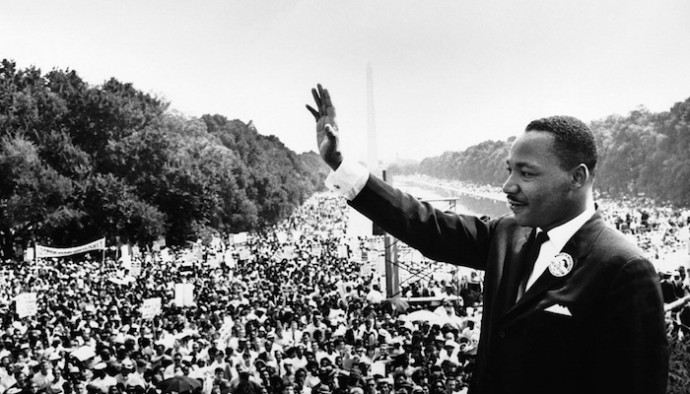On August 28, 1963, Martin Luther King Jr. delivered his famous “I Have a Dream” speech from the steps of Lincoln Memorial, capping a historic March on Washington:
It’s a dream that has not yet been realized. Not even close. But it’s a dream that must be, for as Paul pointed out in the book of Ephesians, the validation of the gospel is at stake.
What is the gospel apologetic in the book of Ephesians? What did Paul point to in order to show the power and reality of Jesus Christ?
It’s not what you might think.
It wasn’t an apologetic of logic – an effort to prove with tangible facts and step by step reasoning why the life, death, and resurrection of Jesus makes sense. Neither was it offering first hand testimonies of encounters with the risen Savior. Neither still was it recounting his own encounter with Jesus on the Damascus Road and pointing to his own dramatic change of life as proof of the gospel. Those are all fine things, but that’s not what Paul held up as the validation for the gospel. Not in this book.
In Ephesians, the gospel apologetic is the church itself.
The church at Ephesus was a racially diverse congregation. Jews and Greeks worshiped alongside each other, and that last point is key. There wasn’t a Jewish worship service at 9 and a Greek service at 10:30, each with different music and different communication styles. Instead, there was one, unified congregation. That’s not to say they didn’t have their troubles; they certainly did. But they were together under one head. That, according to Paul, is the most convincing evidence that the gospel is real:
“But now in Christ Jesus, you who were far away have been brought near by the blood of the Messiah. For He is our peace, who made both groups one and tore down the dividing wall of hostility” (Eph. 2:13-14).
Interesting, right? Not logic. Not personal testimony. In Ephesians, it’s the unity of the church – specifically, the racial unity – that validates the reality of the gospel. Makes you wonder whether our churches are validating the gospel in a similar way.
Look around us, and there are still walls. Still hostility. Still division. And so the call to live out the dream resounds again today. The problem might be that such a dream is simply not pragmatic. Here’s what I mean:
One of the principles of church growth involves creating homogeneous groups. That is, that the most effective way of growing a church is to create a group, or a church for that matter, where people look, dress, earn, and act similarly to each other. The idea behind it is that people feel most comfortable and attracted to groups that are like them. So in doing this, we target a specific group of people, gear all our marketing efforts toward them, and hope to create a buzz in that specific group of people. The homogeneous unit that’s created becomes the core of the church.
And it works. Make no mistake, it works. Well.
But just because it works doesn’t mean it’s right.
In truth, I like being in churches where people look like me. It’s easier there because I know they’re thinking what I’m thinking. They’re feeling similar things to what I’m feeling. It’s comfortable there. Only one problem – that’s not what heaven is going to be like.
If places where people are different colors, have a different socioeconomic background, or are a different culture make me uncomfortable, then the afterlife has a surprise in store. God has always been cultivating a people of His own, and that people represents every tribe, tongue, and nation. And in heaven, those people will retain their cultural identity. We’ll hear every language being spoken under the sun before the throne of Jesus:
“After this I looked, and there was a vast multitude from every nation, tribe, people, and language, which no one could number, standing before the throne and before the Lamb. They were robed in white with palm branches in their hands. And they cried out in a loud voice: ‘Salvation belongs to our God, who is seated on the throne, and to the Lamb!’” (Revelation 7:9-10).
Now among other things, the church of today is supposed to be a glimpse into the future. It’s a foretaste, a preview of what eternity is going to be like. If that’s true, how can we intentionally or unintentionally try and cultivate a church experience where we all look the same? It’s effective, sure.
But what is pragmatic isn’t always what is right. And what’s right isn’t always pragmatic.
Subscribe to MichaelKelley.co
Never miss a new post. Subscribe to receive these posts in your inbox and to receive information about new discipleship resources.






I (pasty white person) honestly am not against worshiping with black folks…honestly. But in the South, blacks just have a completely different way of worshiping than whites do. Completely. And I’ll be honest, ONE black gospel song is enough for me…the endless repetition just gets on my nerves. But that is the way they love to worship, and hence blacks and whites mostly have separate churches in my part of the country. It’s not because of hostility or racism. It’s cultural. We occasionally get together for revivals and such, but mostly we do our own thing, and I think that’s ok.
Now, if a black person visited our church (and they have) they would be welcomed. And if they then wanted to be a member of our boring white church (not really…for a little country church we’re fairly “progressive”), they would be welcomed. But they would know in advance what they were getting themselves into! 🙂
I guess I said all that to say this…we should not have to “force” the integration of our individual meeting houses. If it doesn’t come naturally (for reasons other than hostility), then no matter. If nothing but whites live in a certain area, what are the churches going to be? All white. Nothing but blacks? All black. Those people are not doing wrong by not going out and trying to “cultivate a church experience” by actively searching for Asians (or whatever) to attend their church.
Those of us who live in the South truly recognize that God offers salvation to people other than whites, and we do know that in heaven there will be blacks, Indians, Asians, etc. singing alongside us in the choir. We do not have to actively seek to emulate that down here to be experiencing the correct “church experience”.